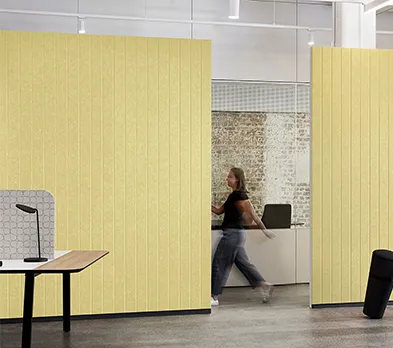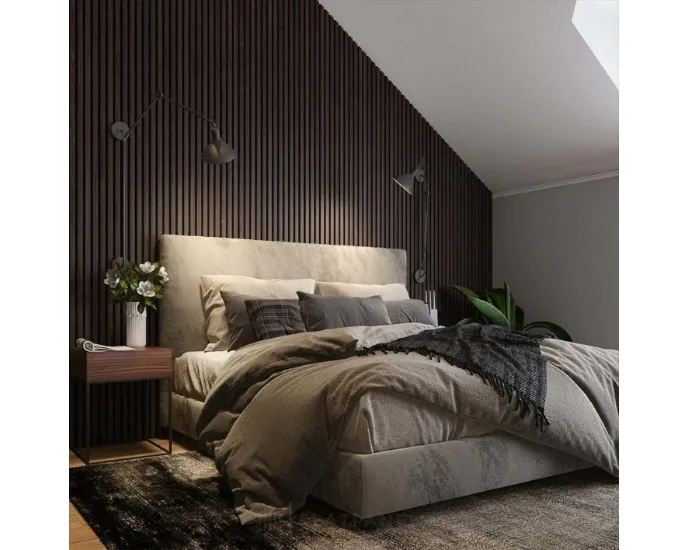Si votre demande n'est pas traitée dans les plus brefs délais, veuillez indiquer votre adresse WhatsApp/Skype dans le message, afin que nous puissions vous contacter dès la première fois.
Nous vous répondrons dans les 24 heures. En cas d'urgence, veuillez ajouter WhatsApp/WeChat : +86-13678899682 directement.
Rooms get loud when hard surfaces bounce noise. Echo makes speech muddy, meetings tiring, and music harsh. The fix is simple: add the right sound-absorbing materials.
Le best sound-absorbing materials are porous, fibrous absorbers comme mineral wool et fibre de verre, which often reach high NRC (Noise Reduction Coefficient) ratings. Open-cell acoustic foam, Panneaux acoustiques en feutre PETet fabric-wrapped wall panels also absorber le son effectively when sized and placed correctly.
We are a professional manufacturer in China specializing in high-quality PET et panneaux acoustiques en bois, providing customized solutions for global B2B clients. In this guide, I’ll keep things clear and practical—so architects, designers, contractors, distributors, and brand owners can quickly pick materials that absorber le son and deliver measurable results.
Pour understand sound, picture ondes sonores traveling through air until sound striking a surface either sound bounces (reflection) or the material absorbs the incident sound energy. When materials that absorb sound work well, the sound energy enters tiny pores, makes the structure vibrate, and is converted to heat. That’s how a sound absorber reduces réverbération and improves la qualité du son.
Materials generally reduce echo in two ways:
“How much sound a material can take in depends on its structure—more pores, more friction, less reflection."
Helpful deep-dive: explore panneaux acoustiques en fibre de polyester for broad-band control and easy finishing: panneaux acoustiques en fibre de polyester.
The best materials share three traits:
These absorption materials absorber les ondes sonores by making air move within tiny passages, causing friction. The material absorbs sound best when it’s open-cell, thick enough for the target band, and not covered by a hard, reflective skin. Think materials like mineral wool, fibre de verre, Feutre PETou mousse acoustique.
Design idea: fabric-wrapped panneaux muraux hide the core and look premium. For ready-to-spec PET options, see Panneaux acoustiques en feutre PET with clean edges: Panneaux acoustiques en feutre PET.

Mousse acoustique is popular because it’s light, easy to cut, and insonorisé look-alike (though foam does not bloquer le son, it absorbs it). Many acoustic foam panels deliver good mid/high l'absorption acoustique, especially for higher frequency sounds. However, mineral wool et fibre de verre often reach higher NRC at similar thickness, and Panneaux acoustiques en PET beat foam on durability, color choices, and safety in public spaces.
Bottom line: foam is fine for studios and homes. For schools, offices, and public areas, designers often prefer PET ou fabric wrapped panels that combine excellent sound absorption avec great sound absorption aesthetics.
Style + function: check decorative PET options that also réduire l'écho: panneaux d'insonorisation.
Here’s a practical CNRC comparison “chart” (typical ranges; always check data sheets). NRC measures how much sound a product loses energy to absorption on average (per ASTM C423). The noise reduction coefficient is a simple 0–1 score: 0 = no absorption, 1.00 = total absorption.
| Material (1″–2″) | Typical NRC (range) | Notes |
| Mineral wool | 0.75–1.05 | Excellent broad-band l'absorption acoustique; robust absorber pour murs et plafonds |
| Fibre de verre | 0.70–1.00 | High performance sound absorption coefficient; stable and consistent |
| PET felt (polyester) | 0.45–0.90 | Versatile, clean finish; strong NRC as thickness increases |
| Mousse acoustique | 0.40–0.80 | Good highs/mids; less impact on deep bass |
| Wool (natural material) | 0.40–0.70 | Eco-friendly; needs thickness and air-gap to shine |
Key takeaways:
Spec hint: build office kits with panneaux acoustiques en polyester for clean looks and consistent NRC: panneaux acoustiques en polyester.
Placement matters as much as product. Early sound reflections cause speech blur. Treat murs et plafonds near people and near sources first.
Application idea: lightweight hanging solutions maximize coverage above desks: Séparateurs suspendus en PET creux.

Panneaux acoustiques en PET bring color, durability, and easy maintenance. As matériaux acoustiques, PET felt offers stable sound absorbing capabilities, consistent batch color, and flexible cutting (logos, baffles and clouds).
For standardized office programs, explore Panneaux acoustiques en polyester PET you can spec at scale: Panneaux acoustiques en polyester PET.
Wood acoustic panels combine warmth with measured control. Perforated or slotted faces let air move through to the absorber backing; slatted profiles scatter and absorber together, raising clarity while preserving lively tone.
See curated options for interiors that need both design and absorption: wood slat wall panel et panneaux acoustiques en bois.

No single product is perfect across all bands. Different types of materials excel in different ranges.
Remember: adding mass to bloquer le son (isolation) is different than adding absorbers to absorber le son (room control).
Pour insonorisé a room, you bloquer le son with mass and airtight layers (l'isolation acoustique, double walls, damped glass). Matériaux d'insonorisation reduce transmission du son through partitions.
Pour absorber le son, you target réverbération inside the room with sound-absorbing materials. The materials used are typically light and poreux.
Think of it this way:
For open offices, absorbers are step one. For privacy suites, add soundproofing insulation to walls and doors.
CNRC is a simple average—good for quick comparisons, but not the whole story. The sound absorption coefficient (by frequency) tells you exactly where a product excels. If speech clarity is the goal, look at 500–2000 Hz data. If bass boom is the issue, scan 125–250 Hz.
Spec checklist (fast):
Product path: for broad office use, we’ve seen great results with panneaux acoustiques en fibre de polyester paired with selective wood slats near glass: panneaux acoustiques en bois.
For fast improvements, mount fabric wrapped panels at ear height on side walls. Add overhead baffles and clouds to cover large zones without disrupting lighting and sprinklers. Leave a small air-gap to boost performance—this little trick can help a thin absorber act thicker.
Frameworks help keep lines straight on long corridors. In large atriums, a grid of baffles acoustiques creates strong control with minimal visual weight.
In an open plan office, speech muddiness came from hard glass and concrete. We added 25% surface coverage: PET felt panneaux muraux at first-reflection zones, a set of overhead baffles above the bullpen, and a wood slat wall panel feature behind reception to scatter and absorber.
Results: réverbération time dropped by ~40%, phone calls felt clearer, and daily fatigue fell. The mix looked premium, matched brand colors, and was simple to maintain.
For brandable, design-forward statements that still absorber, consider PET-veneer options like art mural acoustique finishes: panneaux muraux acoustiques art.
Table—compare common absorbers
| Type | Cœur de métier | Typical Thickness | Where it shines |
| Mineral wool | stone fiber | 25–50 mm+ | Training rooms, theaters, behind slats |
| Fibre de verre | glass fiber | 25–50 mm+ | Ceiling clouds, wall kits |
| Feutre PET | polyester | 9–24 mm | Offices, schools, branding walls |
| Mousse acoustique | polyurethane | 25–50 mm+ | Studios, booths |
| Wool blend | natural fiber | 25–50 mm+ | Eco projects |
Rappelez-vous : place panels near talkers and listeners. Add ceiling coverage where walls are busy.
What’s the best sound absorbing material overall?
For broad-band control, mineral wool et fibre de verre typically deliver top CNRC. For design-driven spaces, Panneaux acoustiques en feutre PET combine strong NRC with durable finishes.
Do panels block noise from next door?
No. Panels absorber inside the room. To bloquer le son, you need soundproofing materials (mass, airtight layers) in the wall or ceiling build.
How many panels do I need to reduce echo?
As a starter rule, treat 20–40% of the hard surface area. Measure and adjust. Watch for hotspots where people talk or where sound bounces off glass.
Is acoustic foam safe for public spaces?
Check fire ratings and smoke performance. Many public projects prefer PET or mineral cores that meet stricter codes.
What is NRC, exactly?
It’s a one-number average that estimates how well a product absorbs mid-band speech frequencies. Higher = more absorption. Always review the frequency curve when you can.
Can wood slats really absorb?
Yes—when slats sit over a porous core like PET or fibre de verre, the system scatters and absorbs. It controls réverbération while keeping a warm, architectural look.
Because every space is different. We build custom PET and wood acoustic panels pour distributors, importers, architects, interior designers, and contractors. From fabric wrapped kits to slat systems, we help you match the coefficient data to the look you want—so spaces sound better and projects run smoothly. If you need samples, color decks, or data sheets, reach out and we’ll help you compare options and pick the best sound absorbing material for your brief.